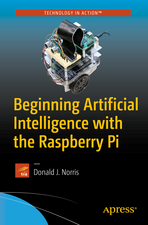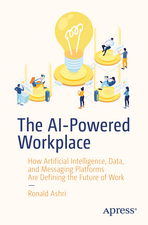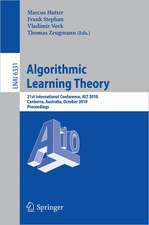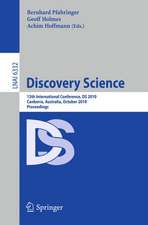Building Machine Learning and Deep Learning Models on Google Cloud Platform: A Comprehensive Guide for Beginners
Autor Ekaba Bisongen Limba Engleză Paperback – 28 sep 2019
Author Ekaba Bisong shows you how machine learning tools and techniques are used to predict or classify events based on a set of interactions between variables known as features or attributes in a particular dataset. He teaches you how deep learning extends the machine learning algorithm of neural networks to learn complex tasks that are difficult for computers to perform, such as recognizing faces and understanding languages. And you will know how to leverage cloud computing to accelerate data science and machine learning deployments.
Building Machine Learning and Deep Learning Models on Google Cloud Platform is dividedinto eight parts that cover the fundamentals of machine learning and deep learning, the concept of data science and cloud services, programming for data science using the Python stack, Google Cloud Platform (GCP) infrastructure and products, advanced analytics on GCP, and deploying end-to-end machine learning solution pipelines on GCP.
What You’ll Learn
Who This Book Is For
Beginners to the practice of data science and applied machine learning, data scientists at all levels, machine learning engineers, Google Cloud Platform data engineers/architects, and software developers
- Understand the principles and fundamentals of machine learning and deep learning, the algorithms, how to use them, when to use them, and how to interpret your results
- Know the programming concepts relevant to machine and deep learning design and development using the Python stack
- Build and interpret machine and deep learning models
- Use Google Cloud Platform tools and services to develop and deploy large-scale machine learning and deep learning products
- Be aware of the different facets and design choices to consider when modeling a learning problem
- Productionalize machine learning models into software products
Who This Book Is For
Beginners to the practice of data science and applied machine learning, data scientists at all levels, machine learning engineers, Google Cloud Platform data engineers/architects, and software developers
Preț: 292.68 lei
Preț vechi: 365.85 lei
-20% Nou
Puncte Express: 439
Preț estimativ în valută:
56.01€ • 57.86$ • 46.62£
56.01€ • 57.86$ • 46.62£
Carte disponibilă
Livrare economică 05-19 martie
Preluare comenzi: 021 569.72.76
Specificații
ISBN-13: 9781484244692
ISBN-10: 1484244699
Pagini: 580
Ilustrații: XXIX, 709 p. 348 illus., 344 illus. in color.
Dimensiuni: 178 x 254 x 22 mm
Greutate: 1.26 kg
Ediția:1st ed.
Editura: Apress
Colecția Apress
Locul publicării:Berkeley, CA, United States
ISBN-10: 1484244699
Pagini: 580
Ilustrații: XXIX, 709 p. 348 illus., 344 illus. in color.
Dimensiuni: 178 x 254 x 22 mm
Greutate: 1.26 kg
Ediția:1st ed.
Editura: Apress
Colecția Apress
Locul publicării:Berkeley, CA, United States
Cuprins
Part 1: Getting Started with Google Cloud Platform.- Chapter 1: What Is Cloud Computing?.- Chapter 2: An Overview of Google Cloud Platform Services.- Chapter 3: The Google Cloud SDK and Web CLI.- Chapter 4: Google Cloud Storage (GCS).- Chapter 5: Google Compute Engine (GCE).- Chapter 6: JupyterLab Notebooks.- Chapter 7: Google Colaboratory.- Part 2: Programming Foundations for Data Science.- Chapter 8: What is Data Science?.- Chapter 9: Python.- Chapter 10: Numpy.- Chapter 11: Pandas.- Chapter 12: Matplotlib and Seaborn.- Part 3: Introducing Machine Learning.- Chapter 13: What Is Machine Learning?.- Chapter 14: Principles of Learning.- Chapter 15: Batch vs. Online Learning.- Chapter 16: Optimization for Machine Learning: Gradient Descent.- Chapter 17: Learning Algorithms.- Part 4: Machine Learning in Practice.- Chapter 18: Introduction to Scikit-learn.- Chapter 19: Linear Regression.- Chapter 20: Logistic Regression.- Chapter 21: Regularization for Linear Models.- Chapter 22: Support Vector Machines.- Chapter 23: Ensemble Methods.- Chapter 24: More Supervised Machine Learning Techniques with Scikit-learn.- Chapter 25: Clustering.- Chapter 26: Principal Components Analysis (PCA).- Part 5: Introducing Deep Learning.- Chapter 27: What is Deep Learning?.- Chapter 28: Neural Network Foundations.- Chapter 29: Training a Neural Network.- Part 6: Deep Learning in Practice.- Chapter 30: TensorFlow 2.0 and Keras.- Chapter 31: The Multilayer Perceptron (MLP).- Chapter 32: Other Considerations for Training the Network.- Chapter 33: More on Optimization Techniques.- Chapter 34: Regularization for Deep Learning.- Chapter 35: Convolutional Neural Networks (CNN).- Chapter 36: Recurrent Neural Networks (RNN).- Chapter 37: Autoencoders.- Part 7: Advanced Analytics/ Machine Learning on Google Cloud Platform.- Chapter 38: Google BigQuery.- Chapter 39: Google Cloud Dataprep.- Chapter 40: Google Cloud Dataflow.- Chapter 41: Google Cloud Machine Learning Engine (Cloud MLE).- Chapter 42: Google AutoML: Cloud Vision.- Chapter 43: Google AutoML: Cloud Natural Language Processing.- Chapter 44: Model to Predict the Critical Temperature of Superconductors.- Part 8: Productionalizing Machine Learning Solutions on GCP.- Chapter 45: Containers and Google Kubernetes Engine.- Chapter 46: Kubeflow and Kubeflow Pipelines.- Chapter 47: Deploying an End-to-End Machine Learning Solution on Kubeflow Pipelines.-
Notă biografică
Ekaba Bisong is a Data Science Lead at T4G. He previously worked as a data scientist/data engineer at Pythian. In addition, he maintains a relationship with the Intelligent Systems Labs at Carleton University with a research focus on learning systems (encompassing learning automata and reinforcement learning), machine learning, and deep learning. He is a Google Certified Professional Data Engineer and a Google Developer Expert in machine learning.
Textul de pe ultima copertă
Take a systematic approach to understanding the fundamentals of machine learning and deep learning from the ground up and how they are applied in practice. You will use this comprehensive guide for building and deploying learning models to address complex use cases while leveraging the computational resources of Google Cloud Platform.
Author Ekaba Bisong shows you how machine learning tools and techniques are used to predict or classify events based on a set of interactions between variables known as features or attributes in a particular dataset. He teaches you how deep learning extends the machine learning algorithm of neural networks to learn complex tasks that are difficult for computers to perform, such as recognizing faces and understanding languages. And you will know how to leverage cloud computing to accelerate data science and machine learning deployments.
Building Machine Learning and Deep Learning Models on Google Cloud Platform is divided into eight parts that cover the fundamentals of machine learning and deep learning, the concept of data science and cloud services, programming for data science using the Python stack, Google Cloud Platform (GCP) infrastructure and products, advanced analytics on GCP, and deploying end-to-end machine learning solution pipelines on GCP.
Author Ekaba Bisong shows you how machine learning tools and techniques are used to predict or classify events based on a set of interactions between variables known as features or attributes in a particular dataset. He teaches you how deep learning extends the machine learning algorithm of neural networks to learn complex tasks that are difficult for computers to perform, such as recognizing faces and understanding languages. And you will know how to leverage cloud computing to accelerate data science and machine learning deployments.
Building Machine Learning and Deep Learning Models on Google Cloud Platform is divided into eight parts that cover the fundamentals of machine learning and deep learning, the concept of data science and cloud services, programming for data science using the Python stack, Google Cloud Platform (GCP) infrastructure and products, advanced analytics on GCP, and deploying end-to-end machine learning solution pipelines on GCP.
You will:
- Understand the principles and fundamentals of machine learning and deep learning, the algorithms, how to use them, when to use them, and how to interpret your results
- Know the programming concepts relevant to machine and deep learning design and development using the Python stack
- Build and interpret machine and deep learning models
- Use Google Cloud Platform tools and services to develop and deploy large-scale machine learning and deep learning products
- Be aware of the different facets and design choices to consider when modeling a learning problem
- Productionalizemachine learning models into software products
Caracteristici
Pedagogically structured to make the knowledge of machine learning, deep learning, data science, and cloud computing easily accessible Equips you with skills to build and deploy large-scale learning models on Google Cloud Platform Covers the programming skills necessary for machine learning and deep learning modeling using the Python stack Includes packages such as Numpy, Pandas, Matplotlib, Scikit-learn, Tensorflow, and Keras



























